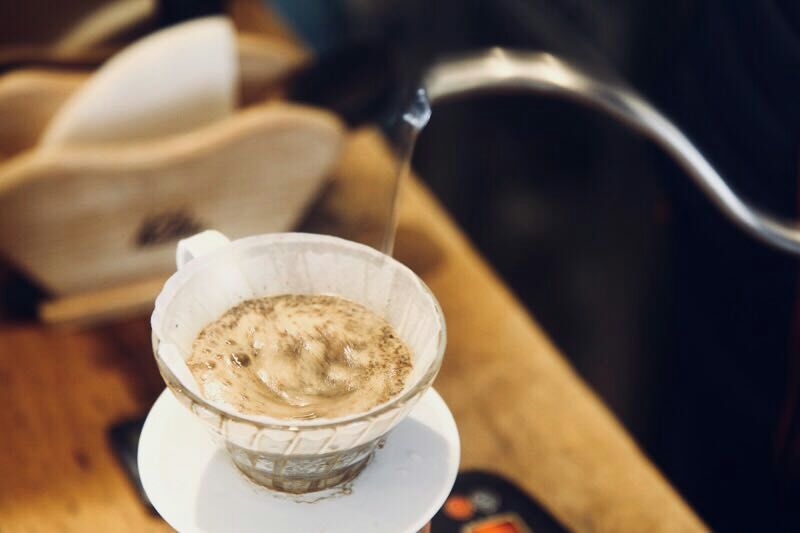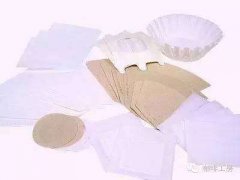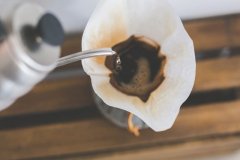How did the world's first coffee filter paper come from? What is the standard aperture of coffee filter paper?

Professional coffee knowledge exchange more coffee bean information please follow the coffee workshop (Wechat official account cafe_style)
Which filter to choose for hand-brewed coffee: comparison of filter paper, metal filter mesh and filter cloth
More than 100 years ago, people used linen or metal mesh to filter coffee, which tasted bitter and coffee grounds often precipitated at the bottom of the cup, German mother Melita. Melitta Bentz, racked his brains to make a delicious cup of coffee.
One day she had an idea and poked several small holes in the bottom of the copper pot.
Then cut the paper of my son's workbook into a circle and put it inside the copper pot.
Unexpectedly, the filtering effect of this blotting paper is excellent, and the bitterness of the brewed coffee is greatly reduced.
As a result, the world's first filter paper and filter cup were born.
After several improvements, Melita was the first to apply for German patents on filter paper and filter cups in 1908, and the products developed were popular all over the world.
Technical index
The technical index of filter paper can be divided into two aspects, one is the filtration characteristics of filter paper, the other is the physical characteristics. Filtration characteristics include air permeability, air resistance, maximum pore diameter and average pore diameter. Physical properties include quantification, thickness, stiffness, corrugated depth, bursting resistance, resin content, etc.
Quantitative: refers to the quality of filter paper per square meter, unit: g/m2.
Thickness: refers to the thickness of the filter paper, excluding the corrugated depth. Unit: mm.
Air resistance: the resistance of filter paper to air flow. Expressed by the pressure drop of 100cm2 filter paper passing through 85 litres of air in one minute. Unit is mbar. Or water column height (mm).
Corrugated depth: the depth of the groove pressed to enhance the longitudinal stiffness of the filter paper, in mm. In general, its value is 0.2mm.
Air permeability: the amount of air passing through the filter paper per unit of time under a certain area and pressure (20 mm water column). The unit is L / m2 ·s.
Nominal filtering accuracy: refers to the ability of filter paper to retain particles of a certain size, and the particle size of a tiny sphere that can be retained or filtered out of 50% shall prevail. Unit: μ m.
Maximum aperture: the void size calculated from the pressure of the first bubble on the filter sample during the test. Unit: μ m.
Average pore size: the pore diameter calculated by the pressure during "dense" bubbling is called the average pore diameter. The unit is μ m.
Resin content: the percentage of resin in the weight of filter paper. Generally speaking, it is 10%, 30%, and 30%.
Stiffness: anti-deformation ability of filter paper. Unit: mg.
Bursting resistance: the maximum pressure that filter paper can bear per unit area. Unit: kPa.
Usage
.
Important Notice :
前街咖啡 FrontStreet Coffee has moved to new addredd:
FrontStreet Coffee Address: 315,Donghua East Road,GuangZhou
Tel:020 38364473
- Prev

Performance-to-price ratio of filter paper and filter paper parameters of common brands where to buy coffee filter paper and how to buy it
Professional coffee knowledge exchange more coffee bean information Please pay attention to the coffee workshop (Wechat official account cafe_style) hand-brewed coffee filter to choose: filter paper, metal filter mesh, filter cloth comparison in the follicular coffee, the use of coffee filter paper, more uniform and fully soak to extract coffee essence, thus getting a purer coffee flavor. How to buy coffee filter paper? Bleached filter paper vs unbleached
- Next

There is no substitute for coffee filter paper-10 wonderful uses of coffee filter paper and you'll see.
Professional coffee knowledge exchange more coffee bean information please follow the coffee workshop (Wechat official account cafe_style) hand-brewed coffee filter to choose: filter paper, metal filter, filter cloth who prefer to use coffee beans or coffee powder to make coffee, should all have the experience of using coffee filter paper, there is more than one shape of coffee filter paper! If you only like instant coffee or don't drink it at all
Related
- What is the Philharmonic pressure? How to use Philharmonic pressure to make delicious coffee
- Why does a hand grinder have more fine powder than an electric grinder?
- In addition to the hot mom, what is the difference between the versions of EK43 | ditting and Mahdi ek43?
- What kind of equipment do you need to make coffee by hand? Introduction to novice starter cooking equipment tools
- Espresso needs to be ground how thick and thin scale entry Italian Coffee Machine Bean Grinder investigation and Grinding course
- How much does it cost to open a small private cafe? How much does it cost to learn coffee? How to operate it?
- The difference between the flavor characteristics of hand-brewed coffee and coffee maker is hand-brewed coffee really better than coffee maker? Can I use a coffee machine to make coffee beans by hand?
- The difference between 01 and 02 of hario v60 filter cup what is the difference between 01 and 02 filter cup opening and cooking flavor
- What's the difference between the smart cup and the French kettle? Which is better, the French kettle or the Smart Cup?
- What's the difference between a smart cup and a V60 filter cup? The difference between the taste of smart cup and hand-brewed coffee

